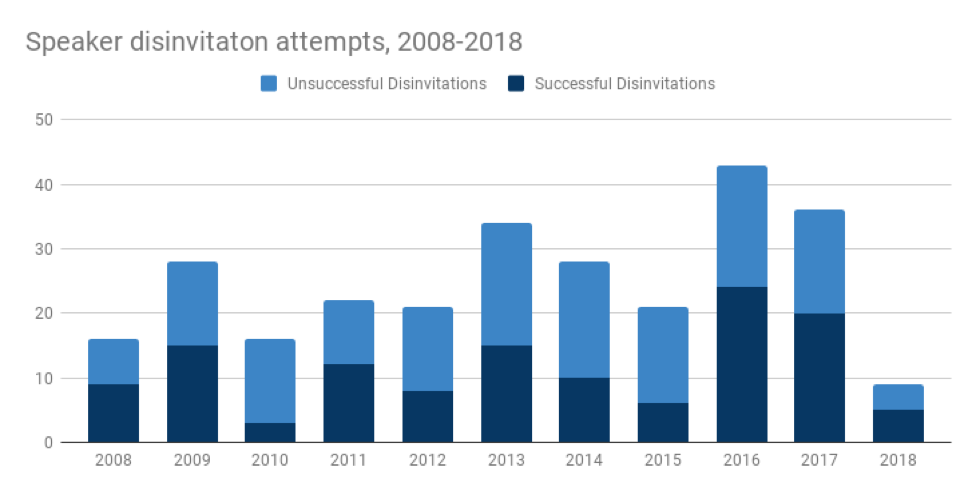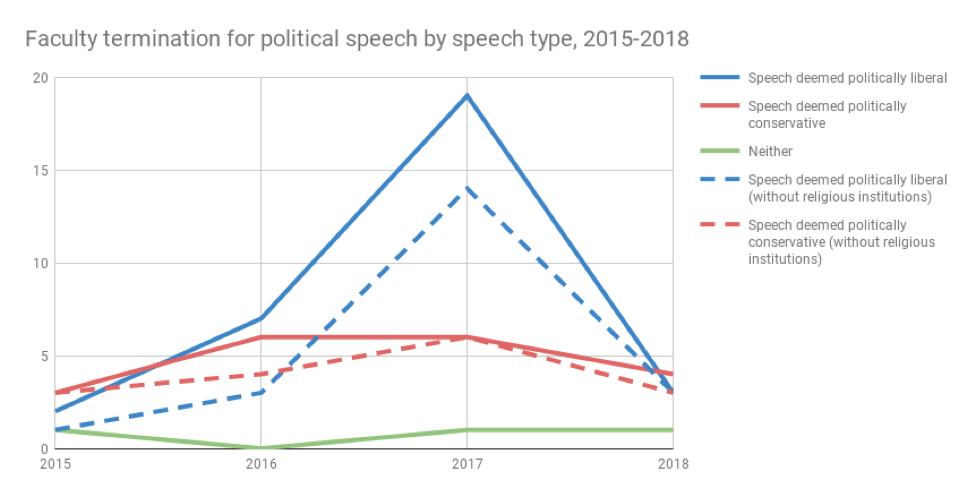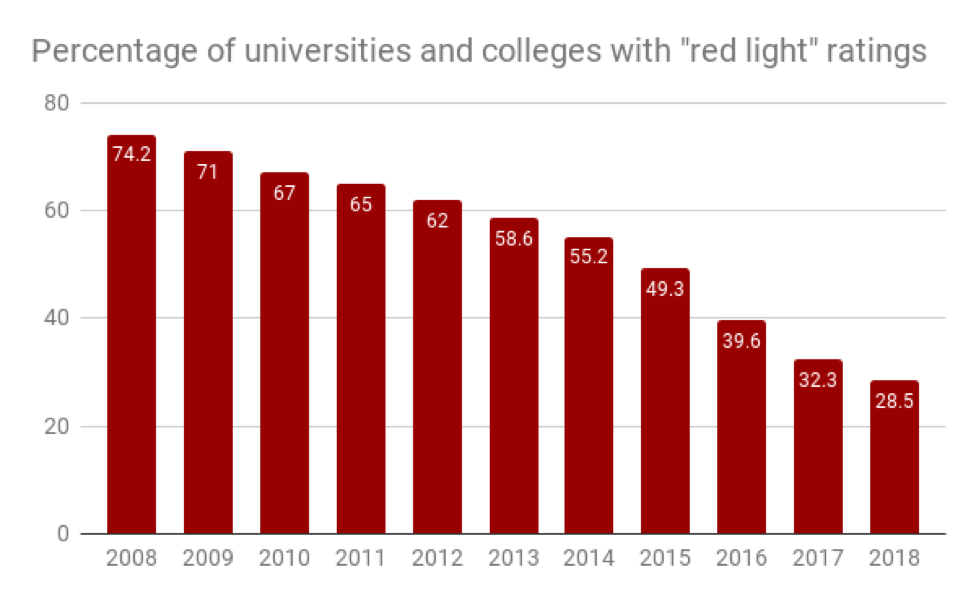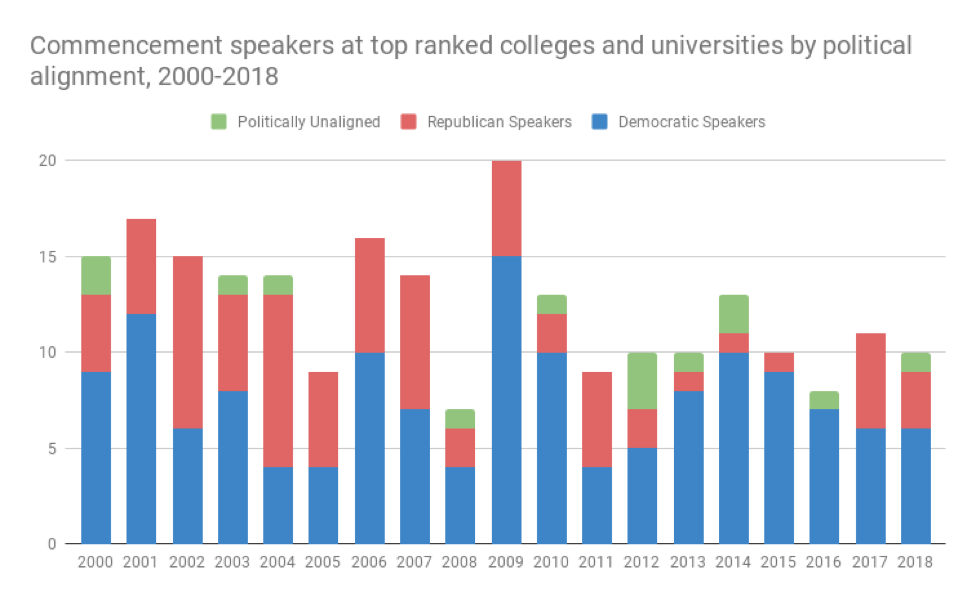What ever happened to the Campus Free Speech Crisis? A year ago, universities were bracing for a new wave of Charlottesvilles. Administrators were predicting more protests, more deplatformings, and more out-of-control student activism. Indeed, the crisis was thought to be so acute that the White House convened a forum to address it, while state legislatures across the country scrambled to pass new laws and regulations.
What a difference a year makes. Rather than collapsing into chaos, 2018 was a year of relative quiet on college campuses. There were fewer deplatformings, fewer fired professors, and less violence compared to 2017. There was also more dialogue, greater respect for faculty free speech rights, and increased tolerance on both the right and the left. All of which raises the question: what went right?
Before getting to that, it is worth being clear on one thing from the outset: to call 2018 “quiet” is not to say that it was silent. There were serious incidents on some campuses. Student activism, free speech, and academic freedom all faced their fair share of threats last year. Some of those threats were old and familiar; others were new. We’ll look more closely at each in a moment. But while there is a danger in exaggerating recent improvements, there is also a danger in ignoring or downplaying them. Progress is being made and it makes sense to figure out why.
Now, some numbers.
Back in 2016, when the alarm over campus free speech was at its height, the Foundation for Individual Rights in Education (FIRE) recorded 43 “disinvitation attempts”. These are episodes in which one segment of the campus community attempts to block an invited speaker from speaking, and can range from mass protests and deplatformings to the circulation of a petition. The number of disinvitation attempts dipped slightly in 2017, but remained quite high by historical standards.

Source: FIRE Disinvitation Database
Figure 1: Speaker disinvitation attempts
This past year, the number of disinvitation attempts fell to nine. That number is likely to increase a bit as investigations into several potential cases are concluded, but the final tally will almost certainly represent an enormous drop from previous years. And of those nine attempted disinvitations, only five were successful, with one speaker re-invited back to campus the following month. While a small number of protests early in the year turned violent, none came close to matching the chaos seen at Berkeley or Columbia in 2017. Even speakers like Ann Coulter and Dinesh D’Souza, who in the past have both generated a heated campus response, were able to speak in 2018 without incident.
But it wasn’t just disinvitations that dropped in 2018. So did the number of professors terminated for political speech.1 In 2016, 14 faculty members were either fired, demoted, or forced to resign for politically controversial speech, a significant increase over previous years. In 2017, that number climbed to 28. But this past year, just eight faculty were terminated or demoted – four due to criticism from their political left, three who were criticized from their political right, and one whose critics can’t be characterized in left/right terms. In general, university administrators proved much more willing to defend their controversial faculty, even in the face of public outrage.

Source: The US Faculty Termination for Political Speech Database
Figure 2: Faculty termination for political speech by speech type
Lastly, the number of institutions with restrictive speech codes fell to historic lows. In 2018, just 28% of universities and colleges received FIRE’s “red light” rating (meaning their speech codes were the most restrictive), a drop of 4 percentage points from 2017. Especially significant is that the number of red light ratings awarded to private institutions, which are not bound by the First Amendment, dropped below 50% for the first time since FIRE began collecting this data in 2009.2

Source: FIRE Spotlight on Speech Codes
Figure 3: Percentage of universities and colleges with “red light” ratings
So what happened? What explains these encouraging trends? Obviously there are dangers in drawing firm conclusions from just one year’s worth of data, but clearly something is at work here.
Self-Censorship
Let’s tackle the worst case scenario first: self-censorship. According to this theory, the decline in campus protests and faculty controversies isn’t actually a good thing at all. Rather, it is the product of a pervasive chilling effect. Thus, if fewer conservative speakers are being disinvited on college campuses, it is because they are not being invited in the first place. Or maybe they are being invited, but are too afraid to show up. Either way, what initially looks like a good thing is, in fact, something quite ominous.
Fortunately, there is little evidence to support this theory. Self-censorship does happen, especially in the classroom and among contingent faculty. However, there is no indication that it is responsible for 2018’s drop in deplatformings or faculty terminations. Few examples of such self-censorship exist, and those that have been proposed (e.g. Milo Yiannopoulos at UCLA, Richard Spencer’s entire campus tour) have been undermined by subsequent reporting.
Of course, self-censorship is, by its very nature, difficult to spot. The problem is that we do not know how many controversial speakers to “expect” on campus each year. Without that piece of information, we cannot say for certain whether 2018’s decline actually represents improving conditions and not a worsening climate of fear.
That’s where commencement speakers come in. Most commencement ceremonies feature a single keynote address, meaning that we know roughly how many invited speakers to expect each commencement season. Last June, FIRE noted that the spring commencements in 2018 were far less likely to be deplatformed than in previous years, a development that it attributed to the decision by administrators to only invite non-political (and in particular non-conservative) speakers. This effectively amounts to self-censorship, albeit for an event that is more celebratory than substantive.
However, FIRE’s dataset, which surveys speaker trends in the sixty top ranked colleges and universities, only covers six years’ worth of ceremonies. A fuller dataset spanning the last 18 years shows that 2018 was largely in line with recent trends, suggesting that a sudden shift toward non-political speakers probably cannot explain the drop in disruptive protests.3 Moreover, commencement speakers are typically chosen by administrative committees, making them a poor reflection of campus speaker trends overall. Note, however, that this larger dataset confirms FIRE’s findings about the imbalance between Democrats and Republicans. This imbalance dates back to the election of Obama in 2008 and has only been partly redressed under Trump.

Source: The US Undergraduate Commencement Speaker Database
Figure 4: Commencement speakers at top ranked colleges and universities by political alignment
In short, the evidence for a chilling effect, particularly in regards to invited speakers, is sketchy at best. By contrast, the evidence for a heating effect is quite robust. Many students explain that the only reason they choose to invite controversial speakers to campus is to challenge or provoke their classmates. Meanwhile, conservative organizations like Turning Point USA and Young America’s Foundation proudly tout the ability of their speakers to “trigger” liberal students. In fact, generating student outrage, even to the point of being deplatformed, has become such a badge of honor that some speakers are fabricating deplatforming incidents where none exist.
Again, this is not to say that self-censorship does not occur (though few real-world examples are forthcoming), but rather that it is unlikely to explain recent trends. Moreover, the case that self-censorship explains the drop in deplatforming incidents must be balanced against a well-documented surge in the intentional invitation of inflammatory campus speakers. At any rate, the vast majority of controversial speakers appear on campus without incident.
Legislative and Policy Changes
Another possible explanation is the adoption of new laws or policies. In 2017, six states adopted some sort of legislation designed to protect campus speech, ranging from a simple affirmation of students’ First Amendment rights (e.g. Virginia) to bans on so-called “free speech zones” (e.g. Utah and Colorado) to new rules that set mandatory punishments for disruptive protesters (e.g. North Carolina and the University of Wisconsin system). Going further, Tennessee has barred institutions from rescinding invitations to speakers, a move that would eliminate outright the possibility of deplatforming.
However, these laws are almost certainly not responsible for last year’s drop in disinvitations. First of all, they only apply to public institutions in six states, whereas the drop occurred in all types of institutions and was visible across the country. Indeed, of the 68 “repeat offenders” in FIRE’s disinvitation database (universities or colleges at which more than one disinvitation attempt has taken place since 2000), only two institutions – UNC Chapel Hill and Virginia Tech – could possibly have been affected by these new laws. Second, with the exception of Tennessee’s, none of these laws should be expected to affect the incidence of non-disruptive disinvitation attempts (e.g. petitions and complaints). Time will tell whether these laws can have a demonstrable impact on campus, but there is little evidence so far that they have.
Another important development in 2017 was the popularity of the University of Chicago Free Speech Statement (the “Chicago Statement”), which has now been adopted by 56 colleges and universities. As a broad expression of commitment to free speech, this statement signals an institution’s unwillingness to indulge attempts to disinvite speakers or terminate faculty, thereby potentially reducing the number of attempts that take place. Because twelve of the disinvitation database’s repeat offenders are signatories of the statement, it is a more plausible explanation than new campus free speech laws. However, the numbers are still very small and do not include many of the “worst” institutions (Harvard, DePaul, any of the University of California schools). There is also an obvious endogeneity problem: the schools most likely to sign the Chicago Statement are probably also the ones least inclined to tolerate deplatforming or attacks on faculty speech in the first place. I put this explanation in the “possible but unlikely” category, but your mileage may vary.
Tactics and Counter-Tactics
So, if not self-censorship, and if probably not new laws or policies, what does explain the changes on campus last year? Well, protests and deplatforming are tactics, and like all tactics, they tend to lose their effectiveness over time. What first has the advantage of novelty becomes familiar and, eventually, anticipated. Often this triggers a cycle of tactical innovation and adaptation, in which the targets of activism develop their own counter-tactics in response.
Campus politics is no different. By now, university administrators, student organizations, and controversial speakers themselves all have a wide repertoire of tactics at their disposal to counter disruptive student activism. Common examples include increased security, invite-only ticketing, and preemptive affirmations of university values, all of which were deployed throughout 2018.
Some counter-tactics defy easy categorization. For example, a plan by Montana activists to register all tickets for, and then not attend, a conservative event was foiled when the inviting organization painstakingly re-authenticated the registrations. And administrators at California Polytechnic State University, alarmed by the possibility of violent protesters during a Yiannopoulos event, scheduled a “Unite Cal Poly” festival for the same time elsewhere on campus.
Other counter-tactics arguably cross an ethical (and possibly legal) line. For instance, both Yiannopoulos and conservative commentator Ben Shapiro have accused universities of purposefully scheduling their events at inconvenient times and locations in order to dampen turnout (though the dispute with Yiannopoulos was eventually resolved amicably). Meanwhile, Baylor University’s administration was caught trying to infiltrate and spy on a sexual assault survivors group, and a conservative professor at Stanford University was forced to resign from a free speech club after leaked emails revealed that he had solicited “opposition research” on a left-wing student. And when members of campus minority groups purchased tickets to a Ben Shapiro talk, event organizers, fearing that these students were plotting a disruption, preemptively revoked and refunded their tickets.
These last cases are concerning, but they are also outliers. For the most part, campus administrators have adopted a fairly anodyne list of best practices in order to address student concerns and prevent deplatformings. In this, they have been increasingly guided by advocacy groups like FIRE, PEN America, and Heterodox Academy, which share advice on how universities can balance their commitments to free speech and public safety.
A new culture on campus?
Finally, there are hopeful signs that a new culture of tolerance is taking hold on campus.
In colleges and universities across the country, students are forming new clubs and networks dedicated to respectful dialogue. Campus leaders are following suit, explicitly affirming the value of free speech and establishing protocols for its protection. Among conservatives in particular, there is a renewed emphasis on inviting speakers of substance, as opposed to those who seek merely to provoke.
For faculty, there are encouraging signs as well. Despite powerful campaigns to pressure universities into firing controversial professors, the vast majority of administrators held firm to principles of academic freedom. Indeed, a survey carried out by the conservative American Enterprise Institute found overwhelming support for academic freedom throughout the professoriate. While threats to faculty persist (including, ironically, to the survey’s author), universities appear much less willing to placate their outraged critics than they did in 2017.
Why the new culture of tolerance? Some of it, I suspect, is due to the efforts of groups like PEN America, FIRE, and Heterodox Academy, which have been working tirelessly all year to promote dialogue and protect free speech. Fear of litigation is also likely to have made a difference. But I suspect the broader national political climate may be an even more important factor. Few observers truly appreciate how deeply the culture on campus is shaped by events taking place off it, which is why I suspect there is too little recognition that many of the events of 2016 and 2017, when concern about the “Free Speech Crisis” was at its height, were tied to the presidential election.
Trump’s campaign and victory generated enormous consternation among many students and faculty, leading some to embrace confrontational forms of activism. In this, they were no different from activists off campus. But as that initial surge of panic has receded, so has the combative sense of urgency and alarm that drove campus activists when it was vivid and fresh. In other words, it is probably not that students are suddenly being won over by Mill’s On Liberty. Nor is it that they now see the value of what Charlie Kirk or Ben Shapiro bring to campus. Rather, it is just that they are beginning to find them boring.
This might not sound like tolerance, but it is
Few people saw the improvements of 2018 coming. Interestingly, one of the few who did was social psychologist and Heterodox Academy co-founder Jonathan Haidt, who predicted in late 2017 that conditions on campus were poised to improve. Haidt got some of the details wrong. For example, he thought that there would be more free speech controversies in spring 2018, but there turned out to be fewer. But he was nevertheless on to something. The culture, tactics, and networks on campus have begun to change, and for the better.
What does this all mean? Well, let’s start with what it does not mean. It does not mean that there are no threats to free speech on campus. Many institutions still levy excessive security fees on controversial speakers or block them outright. Religious colleges and universities regularly censor student speech and press. And a growing number of states have passed laws barring supporters of the anti-Israel Boycott, Divestment, and Sanctions (BDS) movement from contracting with (or seeking reimbursements from) public universities. Free speech on campus is not – and probably never will be – entirely secure. The work of free speech advocates is never done.
Nevertheless, it may make sense at this time to rethink the link between conditions on campus and larger generational trends. According to one popular theory, young people today subscribe to a “culture of victimhood,” one that fosters in students a feeling of vulnerability and intolerance. Maybe, maybe not. But considering how quickly the situation on campus has changed, there is reason to doubt the theory’s ability to explain student behavior.
Lastly, this may also be a good moment to revisit some of the policy choices made during the height of the “Free Speech Crisis” of 2016 and 2017. While they are for the most part well-intentioned, these laws and policies arguably pose a threat of their own to the campus community. Hopefully, their advocates will take this opportunity to pause and reflect on whether, given the improvements of 2018, they are really in the academy’s best interest.
Endnotes
1. You can read more about the US Faculty Termination for Political Speech Database here.
2. FIRE’s dataset excludes religious universities and other institutions that lack explicit commitments to free speech. This decision is defensible, but controversial.
3. My dataset differs from FIRE’s in two important respects. First, it corrects several errors that materially alter the overall count (e.g. coding Republicans Charlie Baker and Susan Collins as politically “unaligned”, confusing Amherst College with the University of Massachusetts at Amherst). Second, it adopts a more rigid definition of what qualifies a speaker as politically aligned: he or she must have (a) been elected to a political position; (b) been running for an elected position at the time of the commencement ceremony; (c) served in a presidential cabinet or cabinet-level position; (d) served on a Federal Circuit Court, state supreme court, or the US Supreme Court; or (e) been a First Lady. The goal of these criteria was to limit the dataset to speakers whose political affiliations are reasonably likely to have been known to students.